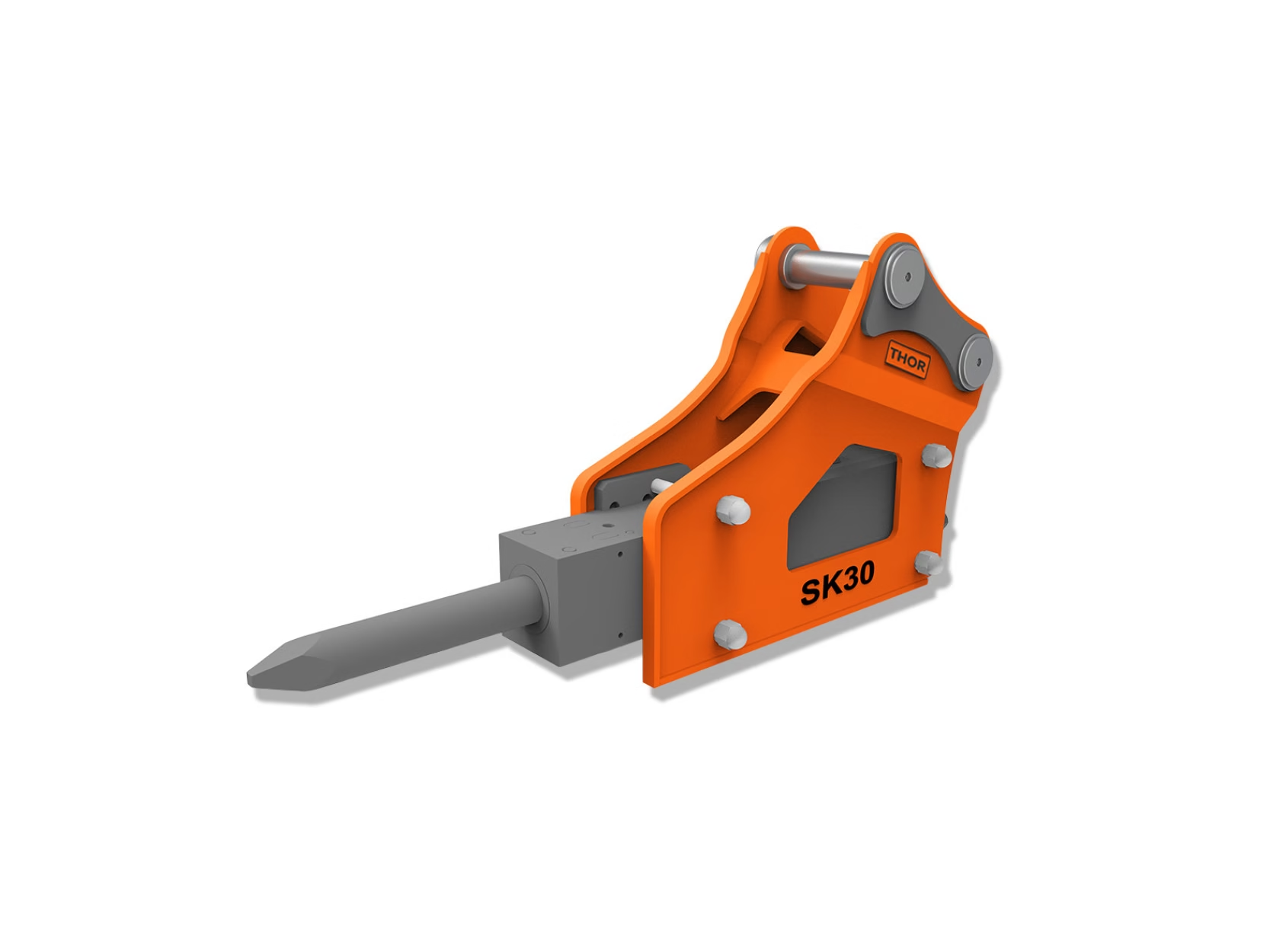Suitable Excavator
0.8 - 1.1 TON
CLASS*A Grade/Hire Grade
Weight 77 Kg
Suitable Excavator
0.8 - 1.1 TON
CLASS*A Grade/Hire Grade
Weight 99 Kg
Suitable Excavator
0.8 - 1.1 TON
CLASS*A Grade/Hire Grade
Weight 102 Kg
Suitable Excavator
1.2 - 3 TON
CLASS*A Grade/Hire Grade
Weight 99 Kg
Suitable Excavator
1.2 - 3 TON
CLASS*A Grade/Hire Grade
Weight 121 Kg
Suitable Excavator
1.2 - 3 TON
CLASS*A Grade/Hire Grade
Weight 126 Kg
Suitable Excavator
2,2 - 4 TON
CLASS*A Grade/Hire Grade
Weight 132 Kg
Suitable Excavator
2,2 - 4 TON
CLASS*A Grade/Hire Grade
Weight 148 Kg
Suitable Excavator
2,2 - 4 TON
CLASS*A Grade/Hire Grade
Weight 151 Kg
1. Overview Hydraulic breaker attachments (also called hammers or peckers) are used with mini excavators to break concrete, rock, and asphalt in construction, demolition, and utility trenching.
2. Types of Breaker Attachments Breakers can be categorized by their mechanical design , energy source , and housing configuration .
2.1. By Energy System Type Description Advantages Common Use Hydraulic (Gas-Assisted) Uses hydraulic oil pressure plus nitrogen gas in an accumulator to drive a piston. High impact energy, compact, efficient. General construction, rock breaking. Pure Hydraulic Impact generated purely by hydraulic oil — no nitrogen chamber. Consistent blow rate, easy maintenance, low vibration. Concrete demolition, trenching. Gas-Type (Nitrogen Only) Simpler system using compressed nitrogen for energy storage. Lightweight, fewer moving parts. Light demolition, residential work. Accumulator-Type (Hybrid) Combines hydraulic flow and gas accumulator for high efficiency. Strong impact power, smooth performance. Hard rock breaking, quarry applications.
2.2. By Housing Type Housing Type Description Features Applications Open Frame (Side Type) Exposed cylinder and piston design with side plates. Easy service access, lighter weight. Rural jobs, low-noise not required. Box / Silenced Type Fully enclosed housing with polyurethane dampers. Low noise and vibration, protects internal parts. Urban areas, residential work, noise-sensitive sites. Top Type (Direct Mount) Compact, light design mounted directly below the boom. Simplifies installation, good visibility. Tight spaces, small mini excavators (<2 ton). Underwater Type Modified box-type with pressurized air line connection to prevent water ingress. Operates underwater safely. Submerged demolition, dock repair. Side Mount (Offset) Breaker mounted to one side of the boom for trench edge or wall work. Improves reach, keeps boom clear. Trenching, curb demolition.
2.3. By Function / Application Design Type Description Typical Tool Excavator Range Standard Breaker General-purpose hammer for rock and concrete. Moil point or chisel 1–4 ton Compact Breaker Lightweight design for ultra-mini excavators. Point tool 1–2 ton Silent Breaker Noise- and vibration-damped with box housing. Flat chisel 1–4 ton Multipurpose Breaker Adaptable for asphalt, trenching, or concrete with tool swaps. Blunt or chisel 2–4 ton Submersible Breaker Modified for underwater demolition. Point tool 2–4 ton Vibration-Damped Breaker Internal dampers isolate impact force from excavator arm. Any tool type 1.5–4 ton
2.4. By Tool Configuration Each breaker type can use interchangeable tools (chisel bits) depending on the job:
Tool Type Shape Application Moil Point Tapered round General rock and reinforced concrete Flat Chisel Flat, sharp edge Concrete, asphalt, controlled breaking Narrow Chisel Slim blade Trenching, fine demolition Blunt Tool Rounded tip Asphalt, compacted material Pyramid Tool Multi-edge point Hard rock, boulders Asphalt Cutter Wide flat edge Road surface cutting
3. Breaker Sizing & Compatibility (Same as in the previous guide — summarized here)
Excavator Class Breaker Weight Impact Energy Flow Rate Pressure 1–1.5 ton 60–100 kg 80–150 J 15–25 L/min 90–110 bar 1.5–2.5 ton 90–150 kg 100–200 J 20–35 L/min 100–120 bar 2.5–4 ton 150–250 kg 150–350 J 25–45 L/min 110–130 bar
4. Key Components (All Breaker Types) Component Function Cylinder / Piston Assembly Generates impact motion Valve Body Controls hydraulic flow Accumulator / Gas Chamber Stores energy for piston strike Tool Retainer & Pins Secure and guide the chisel Housing (Box or Open Frame) Structural protection and sound reduction Bushings Reduce wear between tool and housing Tool (Chisel / Moil) Delivers impact to material
5. Installation & Hydraulic Setup (As described before — with additional note for breaker type differences)
Box-type breakers may require case drain lines.Open-frame breakers usually need only pressure and return lines.Underwater-type breakers require an air compressor line (~0.5 bar above water pressure).Always match the excavator’s hydraulic flow rate to the breaker specification.
6. Typical Breaker Examples by Type Type Example Model Brand Excavator Range Notes Gas-Assisted Box Type Epiroc SB102 Epiroc 1.5–3 ton Silent, gas-assisted Pure Hydraulic NPK PH-1 NPK 1–2 ton Low vibration Open Frame Side Type Soosan SB20 Soosan 2–3 ton Easy to service Compact Top Type Montabert SC6 Montabert 1–2 ton Lightweight Underwater Type MSB200UW MSB 2–4 ton Submersible breaker
7. Maintenance by Breaker Type Breaker Type Key Maintenance Focus Gas-Assisted Regular nitrogen pressure check (every 250 hrs) Pure Hydraulic Valve inspection and seal replacement Box-Type Lubricate tool shank often, check noise dampers Open Frame Tighten side bolts, clean debris from housing Underwater Check air line pressure, change seals frequently
8. Safety Considerations for All Types
Never operate a breaker without contact pressure on the tool.
Avoid side-loading (especially on moil and chisel tools).
Regularly inspect hoses for leaks and abrasion.
For box/silent types: monitor housing temperature — overheating indicates excessive oil flow.
For gas types: only charge nitrogen — never use oxygen or air.
9. Summary: Choosing the Right Breaker Type Application Recommended Breaker Type Notes Residential demolition Box (Silenced) Noise reduction important Rock breaking Gas-Assisted High energy per blow Concrete slab removal Pure Hydraulic Steady, controllable blows Trenching Side Mount or Narrow Chisel Precision control Underwater work Underwater Type Air pressurization required Tight access work Compact Top Type Short overall length









